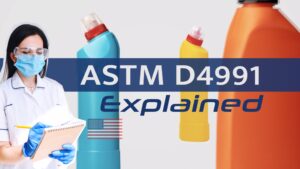Sum up:
ASTM D4991 is a standard test method for testing empty rigid containers for resistance to leakage under differential pressure conditions such as those that may occur during air transport.
 The test involves pressurizing an empty container by immersion in an ethylene glycol-water solution in a transparent test chamber and subjecting it to a gradually increasing partial vacuum. The container is observed for signs of leakage, as evidenced by escaping air bubbles during depressurization or fluid in the container after re-pressurization.
The test involves pressurizing an empty container by immersion in an ethylene glycol-water solution in a transparent test chamber and subjecting it to a gradually increasing partial vacuum. The container is observed for signs of leakage, as evidenced by escaping air bubbles during depressurization or fluid in the container after re-pressurization.
The test method provides a limit of approximately 95-kPa (13.8-psi) differential for establishing the point at which leakage commences. The standard covers testing of rigid containers intended for the transportation of hazardous liquids in accordance with UN TDG and ICAO TIs.
Why to use the ASTM D4991?
This test method is important because it helps to ensure the safe transportation of hazardous materials by air. If a container fails the test and leaks during transport, it could potentially cause harm to people or the environment. By testing containers before transport, it reduces the risk of accidents and ensures that hazardous materials are transported safely.
Test Report:
The report should include identification of the containers and closures, total number of specimens tested, number of specimens tested at one time, test pressure requirement, whether test was performed at ambient temperature, whether test specimens passed or failed the test, whether each test specimen leaked and at what pressure differential, whether test fluid was apparent in each test specimen after testing, a statement to the effect that all tests were made in full compliance with the requirements of this test method, or noting any variations and detailing them, and the name and address of the testing agency, the date, and the signature of a responsible representative of the testing agency.
